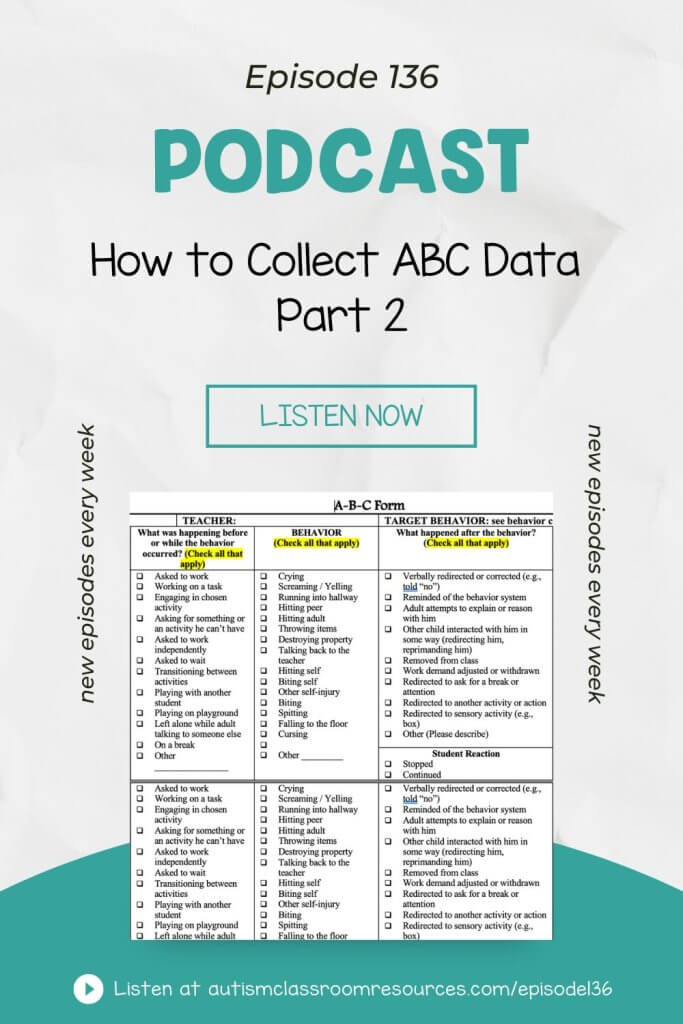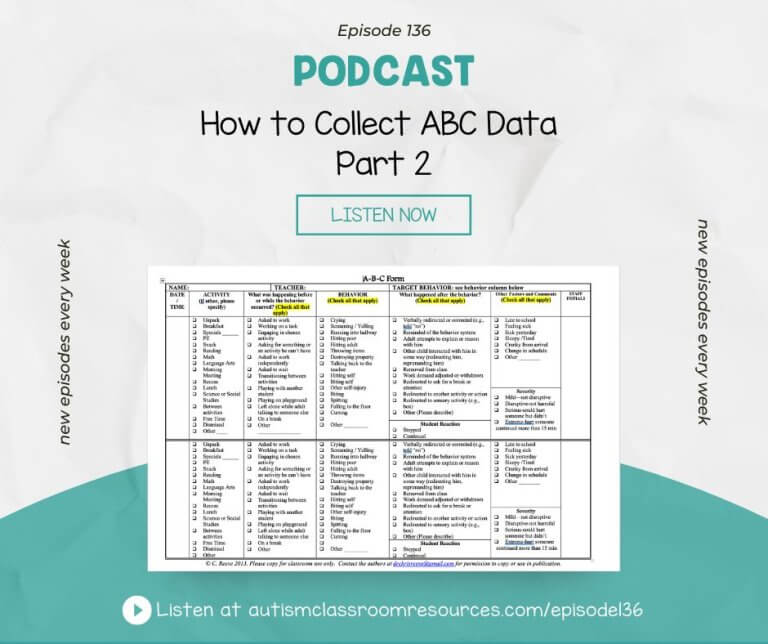Welcome to the Autism Classroom Resources Podcast, the podcast for special educators who are looking for personal and professional development.
Christine Reeve: I’m your host, Dr. Christine Reeve. For more than 20 years, I’ve worn lots of hats in special education but my real love is helping special educators like you. This podcast will give you tips and ways to implement research-based practices in a practical way in your classroom to make your job easier and more effective.
Welcome back to the Autism Classroom Resources Podcast. I’m Chris Reeve. Thank you so much for joining us today. Last week I talked in Episode 135 about some reminders for collecting Antecedent-Behavior-Consequence Data in a functional behavior assessment. Today I want to follow up with a couple more things to think about when you’re taking your ABC Data and a strategy that can help amend some of them if people are having a hard time following the recommendations of just the facts.
I talked last week about the fact that we want to keep our emotions out of it. We want to make sure that we’re just giving people the facts. I’m going to be a little bit more specific today and then I’ll share the strategy with you. I’ve got a free download of those posters that we had for the last episode, as well as a datasheet for you that I will talk about later in the episode. Let’s get started.
When we’re doing an FBA, my assumption would be that we do not know what the function is of the behavior when it’s happening. Because if I could get all that information without having to go through the hoops of taking the data, we could get to treating the behavior a whole lot faster. If you think you already know what the function is, try some strategies that would work for that, and see if it makes a difference.
Yes, it is best practice to have data but you could do that while you’re taking the data and look at whether or not teaching him a specific communication strategy is making the behavior better or worse. Because it’s very hard for some people at times to keep their thoughts and their assumptions about behavior out of the data collection. We talked last week about the fact that you want to keep your emotions out of it and you want to just be very objective in what’s being recorded. We want to do that not just because the information is actual documentation that anyone can access, but also because it just doesn’t give us good information if what you’re telling us is what you assume.
If we just had your assumptions, I can interview you, you get that information, and nobody would have to go through the ritual of collecting the data. Because at that point, if that’s the information that we’re getting, it’s more of a ritual than a necessity. One of the other things you want to do when you’re taking that data is to write only what you can actually observe with your eyes, not things that you think have to do with the behavior or don’t have to do with the behavior.
We all have feelings and emotions, and the challenging behavior will bring out the most of them in most situations, so I’m definitely not debating that. We are emotional. We are human beings. We have emotions, but we don’t know what someone else’s emotions are just from watching them. We may think we do, but we really don’t. Most of you probably know someone who gets really quiet when they get angry. You know to tiptoe around them until it wears off because that is not a good sign.
Other people, when they get angry, throw things and scream. Just knowing that someone is angry doesn’t really tell me what he’s doing. It doesn’t necessarily tell me why he’s angry. How many times have you had an argument with a good friend or significant other and discovered partway through that the thing that you are mad about is not actually something that they were thinking, that your thoughts about their thinking were influencing your behavior more than their actual behavior?
You were interpreting their behavior in a way that maybe wasn’t terribly accurate. You thought that your significant other was very jealous of other people that you were working with, when really he just was tired of never seeing you. We want to make sure that we are looking at what we can actually see and not what we are assuming someone is feeling.
One of the reasons is we get better data. The other is if we’re dealing with feelings, that can’t change feelings, well, you can actually change mood, but if we’re dealing with feelings, we are giving it over to the idea that this person is angry and this behavior is inevitable, as opposed to it’s happening because in his environment, it’s getting him this and it’s removing him from that. That tells me what I can teach him instead.
Yes, I could teach him some anger management, and there probably are emotions that are related to some of our behaviors that we see in our classrooms, but they just don’t help us in making decisions. Think about the difference between these two statements. He decided to kick the student as opposed to he kicked the student as he walked by his desk, “he decided” seems to make it seem that the student is aware, responsible, made a definite choice, that they actually sat there and said, “I don’t like that kid. I’m mad at him. I’m going to kick his desk and let him know.”
Maybe that is what happened. Maybe he tripped. Maybe he did that because when he does that, the kid throws a giant fit. It’s like a giant cause and effect toy that I can make this reaction in my classroom, which then gets the teacher distracted and she doesn’t notice that I’m not doing my work. There can be a lot of things that go into that. We’re better off just knowing the behavior. He hates the math teacher, versus Simon exhibits the most-frequent challenging behaviors in math class.
My assumption when I hear that second statement is math is hard for Simon. Math is a problem, not the teacher is the problem. But the first one kind of says he hates the teacher and that’s the problem. Is it possible that he hates the teacher? It certainly is. Can I fix that? Probably not as much as I can fix helping him deal with whatever else is going on in math. We want to make sure that we are describing things without those emotions, without those assumptions again that I talked about last week.
Finally, the thing that I think you also want to think about is don’t replace your observations with your assumption or interpretation of the data and its function. For those of us who get that there is a purpose for challenging behaviors and challenging behaviors serve a function, it is hard for us to remember that when we’re taking data, we need to just record what happened and not try to figure out why at that moment.
When we say he kicked her because he wanted her attention, we may or may not be right. It’s more precise to say he kicked her and then made eye contact with her and laughed, which might indicate that he was looking for a reaction. Maybe he did think it was funny. Essentially, just remember that if we knew the function of the behavior, we would need to take the data.
Presuming the function when we’re describing the behavior, the antecedents, and the consequence gets in the way of interpreting it differently that might lead to other patterns that might actually address this behavior.
It’s sometimes a lot of the reason why our functional assessments don’t lead us to better treatment is because we’ve got the assumptions built into our data. For instance, don’t say he tried to get her attention when what you saw was he kicked the teacher when she was talking to another student. It’s okay to write that the possible function might be that when you’re recording the data, that you think this might have been what the function was, then we have separated the data from the assumption.
If we knew the function, we wouldn’t need to take the data is really the takeaway with that one. Now, one of the ways that you can help this, because one of the things that I know as a consultant coming in, I often needed data to be taken by the classroom staff because I wasn’t there all the time, like being there might have changed the behavior, all sorts of different reasons, that is an extra step for the classroom staff and not all of them have the level of training that we’d like them to have to follow through because we need data from paraprofessionals as much as the teacher.
We need to know when the students are with them, what behaviors they are seeing. One way that I deal with some of these issues is that once I have an idea about what is going on with the students, I can see common antecedents and common consequences that might happen, I create a checklist datasheet. I can do it on an index card or sheet of paper, it just depends on the situation and what the staff prefers. But essentially, it’s saying in the antecedent column, “Check off everything that happened.”
I list some common things that might be going on in the classroom in general, and in the classroom when the behavior occurs. Then I list his challenging behaviors that we’ve seen and decided upon because that’s what we’re assessing in this FBA. Then I list what are the common reactions that happen in the classroom? What could they be and what have I seen happen? There’s more in there than just what I’ve seen, because otherwise, I would just use my observations and we wouldn’t need more.
That way, it gets away from the “nothing happened” or “it’s emotion”. It gives them a forced choice. There’s always an other bar where they can write in, but that allows me to see what actually happened versus what they are interpreting or assuming has happened. It can make it easier. I want to make it clear that they’re going to check off everything that happens so they’re not limited to just one thing, which I think a lot of times staff are used to looking for one thing that set off the behavior.
I’ve got a free ABC datasheet PDF with those check offs that I use and some explanation free for you as part of this episode. Head over to autismclassroomresources.com/episode136. You can download the datasheet there.
Thank you so much for joining me today. If you have questions about data collection, or just want to geek out on any kind of data, come join our free Facebook group at specialeducatorsconnection.com and let us know that you are a teacher, a para, a behavior therapist, or related service provider and we will get you in to join our discussion. Thank you so much for joining me. I hope this has been helpful and I hope I’ll see you again next week when we’re going to start talking about visual support.






